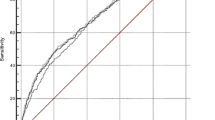Abstract
To study the relationship between dietary calcium intake, load-bearing activity, reproductive factors, anthropometric factors and vertebral fracture in Chinese, a case-control study was carried out on 481 women (aged 70–79 years) who lived in three housing blocks under the Geriatric Priority Housing Scheme in Shatin, Hong Kong. Lateral spine radiographs were taken from the T4 to L4 level. Definite and doubtful vertebral fractures were diagnosed when any of the three vertebral height (anterior to anterior, middle to posterior and posterior to posterior) ratios was 3 SD and 2–2.99 SD below the mean respectively. Women with one or more definite fractures were classified as definite cases, those with one or more doubtful fractures were classified as doubtful cases, and the rest as controls. The mean dietary calcium intake and load-bearing activities were obtained by interview, using a structured questionnaire. Detailed information on cigarette smoking, alcohol consumption and reproductive factors was also obtained. The grip strength, body weight and height were measured. Doubtful cases were found to differ little from the controls in their lifestyle and anthropometric factors. The odds ratio (OR) for being a definite case was 2.1 (95% CI=1.1−3.9) when the dietary calcium intake was in the lowest quartile. The OR was 1.8 (95% Ci=0.8−4.4) for subjects who walked or exercised outdoors for less than an hour a day. Giving birth to or breast-feeding three children or more was protective against definite fracture. The definite cases were significantly lighter and shorter than controls; they also had a weaker grip strength. It is concluded that a low dietary calcium intake was significantly associated with an elevated risk of vertebral fracture, while the effect of infrequent load-bearing activity was uncertain. Giving birth to or breast-feeding three or more children was protective against vertebral fracture in our population.
Similar content being viewed by others
References
Cooper C, O'Neill T and Silman A on behalf of the European Vertebral Osteoporosis Study Group. The epidemiology of vertebral fractures. Bone 1993;14:S89–97.
Lau E, Donnan D, Barker D, Cooper C. Physical activity and calcium intake in fracture of the proximal femur in Hong Kong. BMJ 1988;296:1441.
Van Hemert AM, Vandenbroucke JP, Birkenhager JC, Valken-burg HA. Prediction of osteoporotic fractures in the general population by a fracture risk score: a 9 year follow-up among middle-aged women. Am J Epidemiol 1990;132:123–35.
Johansson C, Melstrom D, Rosengen K, Rundgren A. A community-based population study on vertebral fractures in 85-year-old men and women. Age Ageing 1994;23:388–92.
Black DM, Cummings SR, Stone K, Hudes E, Palermo L, Steiger P. A new approach to defining normal vertebral dimension. J Bone Miner Res 1991;6:883–92.
Food and Agriculture Organization. Food composition table for use in East Asia. Rome: FAO, 1972.
National Osteoporosis Foundation Working Group on Vertebral Fractures. Report on assessing vertebral fracture. J Bone Miner Res 1995;10:518–23.
Peel N, Eastell R. Osteoporosis. BMJ 1995;310:989–92.
Hu JF, Zhao XH, Jia JB, Parpia B, Campbell TC. Dietary calcium and bone density among middle-aged and elderly women in China. Am J Clin Nutr 1993;58:219–27.
Ho SC, Leung PC, Swaminathan R, et al. Determinants of bone mass in Chinese women aged 21–40 years. II. Pattern of dietary calcium intake and association with bone mineral density. Osteoporosis Int 1994;4:167–75.
Cooper C, Barker DJP, Wickham C. Physical activity, muscle strength and calcium intake in fracture of the proximal femur in Britain. BMJ 1988;297:1443–6.
Wickham C, Walsh K, Cooper C, Barker DJP, Margetts BM, Morris J. Dietary calcium, physical activity and risk of hip fracture: a prospective study. BMJ 1989;299:889–92.
Paganini-Hill A, Ross RK, Gerkins VR, Henderson BS, Arthur M, Mack TM. Menopausal estrogen therapy and hip fractures. Ann Intern Med 1981;95:28–31.
Cooper C, Barker DJP, Wickham C. Physical activity, muscle strength, and calcium intake in fracture of the proximal femur in Britain. BMJ 1988;297:1443–6.
Alderman BE, Weiss NS, Daling JR, Ure CL, Ballard JH. Reproductive history and postmenopausal risk of hip and forearm fracture. Am J Epidemiol 1986;124:262–7.
Kreiger N, Kelsey JL, Holford TR, O'Connor T. An epidemiologic study of hip fracture in postmenopausal women. Am J Epidemiol 1992;116:141–8.
Author information
Authors and Affiliations
Rights and permissions
About this article
Cite this article
Chan, H.L., Lau, E.M.C., Woo, J. et al. Dietary calcium intake, physical activity and the risk of vertebral fracture in Chinese. Osteoporosis Int 6, 228–232 (1996). https://doi.org/10.1007/BF01622739
Received:
Accepted:
Issue Date:
DOI: https://doi.org/10.1007/BF01622739




